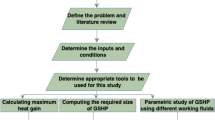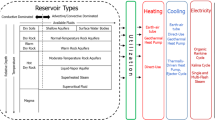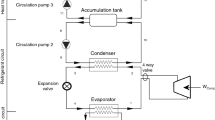Abstract
Basic cooling systems that are available in Nepal utilize higher consumption of energy leading the cost of operation to be high. There is no study regarding the feasibility and possibility of geothermal energy in the context of Nepal. This study looks toward saving energy consumption of the cooling system focusing on the concept of renewable energy, in particular geothermal energy. The study utilizes data obtained from the Terai region of Nepal and looks toward the design and development of a more accurate and acute model of a geothermal cooling system. The cooling system is developed through the drafting of various components and the design of condenser and capillary tubes using the Kern method. The results of the design are analyzed theoretically and experimentally. Economic feasibility analysis is also conducted on the cooling system for data collected in the Terai region of Nepal. The designed geothermal cooling system is found to be much more efficient than a traditional air-cooled cooling system having a theoretical coefficient of performance (COP) around 6.77 and the experimental coefficient of performance around 4.63; variation barring due to manufacturing limitations. The geothermal cooling system is also found to produce maximum performance when the difference between the inlet and outlet of water temperature in the condenser is 9.5–10.5 °C. The cooling system is also found to be economically feasible when used higher than 5 h per day through incremental analysis. Conclusively, the wide held belief that the geothermal cooling system is energy beneficent, and environment-friendly has been confirmed by the design and testing of this system. Furthermore, it also provides a conclusive model as a base for further research in geothermal energy in Nepal—particularly concerning cooling systems.








Similar content being viewed by others
References
J.W. Lund, T.L. Boyd, Direct utilization of geothermal energy 2015 worldwide review. Geothermics 60, 66–93 (2016). https://doi.org/10.1016/j.geothermics.2015.11.004
R. Bertani, Geothermal power generation in the world 2005–2010 update report. Geothermics 41(2012), 1–29 (2012). https://doi.org/10.1016/j.geothermics.2011.10.001
M. Abdel Zaher, H. Saibi, M. El Nouby, E. Ghamry, S. Ehara, A preliminary regional geothermal assessment of the Gulf of Suez, Egypt. J. Afr. Earth Sci. 60(3), 117–132 (2011). https://doi.org/10.1016/j.jafrearsci.2011.02.006
SAARC, Study on geothermal resources of South Asia. Geotherm. Resour. South Asia (2011), http://www.saarcenergy.org/wp-content/uploads/2017/12/2010-Study-on-Geothermal-Resources-of-South-Asia.pdf. Accessed 26 Mar 2019
M. Ranjit, Geothermal energy update of Nepal. In: Proc. World Geotherm. Congr., pp. 25–29, 2010
O. Ozgener, A. Hepbasli, Modeling and performance evaluation of ground source (geothermal) heat pump systems. Energy Build. 39(1), 66–75 (2007). https://doi.org/10.1016/j.enbuild.2006.04.019
A. Mustafa Omer, Ground-source heat pumps systems and applications. Renew. Sustain. Energy Rev. 12(2), 344–371 (2008). https://doi.org/10.1016/j.rser.2006.10.003
M.J. O’Sullivan, K. Pruess, M.J. Lippmann, Geothermal reservoir simulation: the state-of-practice and emerging trends. Proc. World Geotherm. Congr. 2000, 4065–4070 (2000)
R.G. Allis, T.M. Hunt, Analysis of exploitation-induced gravity changes at Wairakei geothermal field (New Zealand). Geophysics 51(8), 1647–1660 (1986). https://doi.org/10.1190/1.1442214
J. Kauffman, K.M. Lee, Handbook of sustainable engineering. Handb. Sustain. Eng. (2013). https://doi.org/10.1007/978-1-4020-8939-8
K. Pruess, C. Oldenburg, G. Moridis, TOUGH2 user’s guide. In: Rep. LBNL-43134, no. September, p. 210, 1999
M.J. Zhan, L. Xia, L. Zhan, Y. Wang, Recognition of changes in air and soil temperatures at a station typical of China’s subtropical monsoon region (1961–2018). Adv. Meteorol. (2019). https://doi.org/10.1155/2019/6927045
S.J. Self, B.V. Reddy, M.A. Rosen, Geothermal heat pump systems: Status review and comparison with other heating options. Appl. Energy 101, 341–348 (2013). https://doi.org/10.1016/j.apenergy.2012.01.048
S. Shinde, H. Pancha, Comparative thermal performance analysis of segmental baffle heat exchanger with continuous helical baffle heat exchanger using Kern method. Int. J. Eng. Res. Appl. 2, 2264–2271 (2012). http://www.ijera.com
S. Patil, Mathematical modelling for thermal and mechanical design of shell and tube type gas cooler used in transcritical CO2 refrigeration system. Int. J. Syst. Sci. Appl. Math. 2(3), 64 (2017). https://doi.org/10.11648/j.ijssam.20170203.11
N.S. Chaudhary, P. Kiran, Shell & tube type water cooled condenser having spiral tube. Int J Sci Res Develop 1(12), 2601–2605 (2014)
P.N. Ananthanarayanan, Basic Refrigeration and Air Conditioning (Tata McGraw-Hill Education, 1980).
K.C. Sahoo, S.N. Das, Theoretical design of adiabatic capillary tube of a domestic refrigerator using refrigerant R-600a. Am. J. Eng. Res. 3(5), 306–314 (2014)
T. Yilmaz, S. Unal, General equation for the design of capillary tubes. J. Fluids Eng (1996). https://doi.org/10.1115/1.2817493
X.-T. Wang, Y.-F. Yan, A. Song, C.-L. Liu, Performance study and analysis of a 300MW high backpressure heat supply unit condenser after retrofit. In: ICSD 2016, vol. 94, pp. 221–227, 2017. https://doi.org/10.2991/icsd-16.2017.49
R. Miller, M.R. Miller, Air Conditioning and Refrigeration, 2nd edn. (McGraw-Hill Education, 2011).
Y. Wang, Q. Gao, T. Zhang, G. Wang, Z. Jiang, Y. Li, Advances in integrated vehicle thermal management and numerical simulation. Energies (2017). https://doi.org/10.3390/en10101636
A. Maier, Cooling’s dynamic duo. Contracting Business, pp. 1–4, 2010. https://www.contractingbusiness.com/home/whitepaper/20869102/coolings-dynamic-duo-pdf-download
A. Hepbasli, O. Akdemir, Energy and exergy analysis of a ground source (geothermal) heat pump system. Energy Convers. Manag. 45(5), 737–753 (2004). https://doi.org/10.1016/S0196-8904(03)00185-7
J.K. Gupta, R.S. Khurmi, A Text Book of Refrigeration and Air-Conditioningitle, 1st edn. (Chand (S.) & Co Ltd, 2006).
A. Girard, E.J. Gago, T. Muneer, G. Caceres, Higher ground source heat pump COP in a residential building through the use of solar thermal collectors. Renew. Energy 80, 26–39 (2015). https://doi.org/10.1016/j.renene.2015.01.063
M. Imal, K. Yilmaz, A. Pinarbaşi, Energy efficiency evaluation and economic feasibility analysis of a geothermal heating and cooling system with a vapor-compression chiller system. Sustainability 7(9), 12926–12946 (2015). https://doi.org/10.3390/su70912926
C.S. Park, Contemporary Engineering Economics, 6th edn. (Pearson, 2015).
Acknowledgements
The work described in this paper was supported by the faculty of Mechanical Engineering at Institute of Engineering, Pulchowk Campus, Nepal to whom the authors are grateful.
Author information
Authors and Affiliations
Ethics declarations
Conflict of interest
No conflict of interest or patents (not-applicable).
Ethical Approval
The data which are collected is by authors who have given full consent in involving themselves in the project.
Consent for Publication
No data from individual personal sources (not-applicable).
Additional information
Publisher's Note
Springer Nature remains neutral with regard to jurisdictional claims in published maps and institutional affiliations.
Supplementary Information
Below is the link to the electronic supplementary material.
Rights and permissions
About this article
Cite this article
Aryal, M.R., Pun, S., Yadav, A.K. et al. Study, Design, and Analysis of Geothermal Cooling System and Its Possibilities in the Terai Region of Nepal. J. Inst. Eng. India Ser. C 102, 777–787 (2021). https://doi.org/10.1007/s40032-021-00669-9
Received:
Accepted:
Published:
Issue Date:
DOI: https://doi.org/10.1007/s40032-021-00669-9




